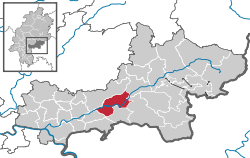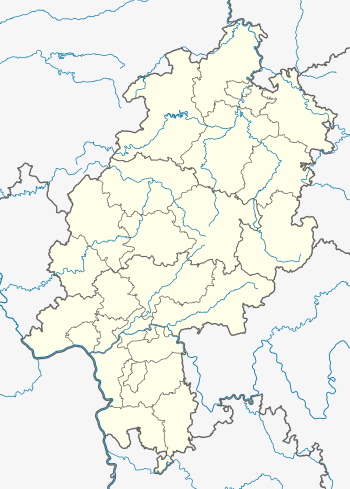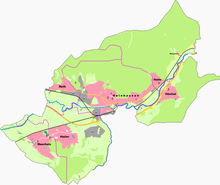Gelnhausen
Gelnhausen is a town, and the capital of the Main-Kinzig-Kreis, in Hesse, Germany. It is located approximately 40 kilometers east of Frankfurt am Main, between the Vogelsberg mountains and the Spessart range at the river Kinzig. It is one of the eleven towns (urban municipalities) in the district. Gelnhausen has around 22,000 inhabitants.
Gelnhausen | |
|---|---|
 View of Gelnhausen with the Marienkirche | |
 Coat of arms | |
Location of Gelnhausen within Main-Kinzig-Kreis district  | |
 Gelnhausen  Gelnhausen | |
| Coordinates: 50°12′N 09°10′E | |
| Country | Germany |
| State | Hesse |
| District | Main-Kinzig-Kreis |
| Subdivisions | 6 districts |
| Government | |
| • Mayor | Daniel Christian Glöckner [1] (FDP) |
| Area | |
| • Total | 45.18 km2 (17.44 sq mi) |
| Highest elevation | 312 m (1,024 ft) |
| Lowest elevation | 180 m (590 ft) |
| Population (2018-12-31)[2] | |
| • Total | 23,073 |
| • Density | 510/km2 (1,300/sq mi) |
| Time zone | CET/CEST (UTC+1/+2) |
| Postal codes | 63571 |
| Dialling codes | 06051 |
| Vehicle registration | MKK, GN, SLÜ |
| Website | www |
Geography
Location

According to the Institut Géographique National from 1 January 2007 until July 2013 the geographic centre of the European Union was located on a wheat field outside the town.
Gelnhausen is located on the German Fairy Tale Route, a tourist route.
History
Imperial City of Gelnhausen Reichsstadt Gelnhausen | |||||||||||||
|---|---|---|---|---|---|---|---|---|---|---|---|---|---|
| 1170–1803 | |||||||||||||
| Status | Free Imperial City | ||||||||||||
| Capital | Gelnhausen | ||||||||||||
| Government | Republic | ||||||||||||
| Historical era | Middle Ages | ||||||||||||
• Founded by Frederick Barbarossa | 1170 | ||||||||||||
• Pledged to Ld Hanau | 1349–? 1170 | ||||||||||||
• Pledged to counties of Schwarzburg and Hohnstein | 26 May 1349 | ||||||||||||
• Hohnstein share to Schwarzburg | 22 July 1431 | ||||||||||||
• Schwarzburg sold to Hanau and the Palatinate | 26 May 1435 | ||||||||||||
• Hanau extinct; share to Lgvt Hesse-Kassel | 28 March 1736 | ||||||||||||
• Palatinate share to Hesse-Kassel | 1746 1803 | ||||||||||||
• Hesse-Kassel raised to electorate | 1803 | ||||||||||||
| |||||||||||||

Gelnhausen was founded by Emperor Frederick Barbarossa in 1170, it is therefore nicknamed "Barbarossastadt". The place was chosen because it was at the intersection of the Via Regia imperial road between Frankfurt and Leipzig and several other major trade routes. Frederick had three villages connected by streets and surrounded by a wall. At the same time, Gelnhausen received town privileges and a Kaiserpfalz was erected on an island of the Kinzig river. The emperor also granted trade privileges like the staple right which forced traveling merchants to offer their goods in the town for three days.
Hence Gelnhausen initially was a thriving trade town and head of a league of 16 towns of the Wetterau region. However prosperity came to an end already in 1326 when Emperor Louis IV gave the town in pawn to the counts of Hanau, redeemed shortly afterwards. In 1349 Count Günther von Schwarzburg received Gelnhausen from Emperor Charles IV for renouncing his claims as elected King of the Romans, in condominium with the counts of Hohnstein, who sold their share to Schwarzburg in 1431. Schwarzburg was acquired in 1435 by Elector Palatine Louis III and the Hanau, since raised to a county.
Repeated plundering in the Thirty Years' War as depicted by Hans Jakob Christoffel von Grimmelshausen in his novel Simplicius Simplicissimus made it nearly uninhabitable. In 1736, the extinction of the comital line of Hanau meant the condominium share was inherited by the Landgraviate of Hesse-Kassel, who acquired the Palatinate's share ten years later.
The varying lords made continued attempts to challenge Gelnhausen's imperial immediacy, it however formally remained a Reichsstadt. During the German Mediatisation of 1803 the city became a part of the Landgraviate of Hesse-Kassel, which was raised to an electorate and, after the Austro-Prussian War of 1866, was annexed by Prussia. At this time Gelnhausen had completely recovered, and with the Gründerzeit economic boom it became a centre of the German rubber industry.
The Holocaust
During the Nazi era, Gelnhausen was reported judenfrei on November 1, 1938, by propaganda newspaper Kinzigwacht after its synagogue was closed and remaining local Jews forced to leave the town.[3]
From the 1930s Gelnhausen was a garrison town of the German Wehrmacht and, after World War II, of the United States Army. The US Army closed Coleman Kaserne in 2007.
In 1996, the town hosted the 36th Hessentag state festival.
Arts and culture
Attractions
Sights include:
- Medieval town center with historic buildings like the Gotisches Haus and the Romanisches Haus
- The Kaiserpfalz Gelnhausen. The castle was erected at the time of Gelnhausen's foundation southeast of the town on an island in the Kinzig river. The groundwork is stabilized by 12,000 logs, driven into the earth. Today it is the best preserved Kaiserpfalz from this era.
- The Marienkirche, the most recognizable landmark of Gelnhausen. It shows both Romanesque (like the six-storey west tower) and Gothic architecture (the octagonal crossing tower and the east towers) elements. The church was built from local bunter between 1170 and 1250 by Selbold Abbey, replacing a simple chapel from ca. 1100 of which some traces remain. In 1543, Gelnhausen turned Protestant and the church became the Protestant parish church.[4]:18
- The Catholic church of Saint Peter. Its origins lie in the early 13th century; rich citizens of Gelnhausen planned to erect a church within the town, causing a conflict with the Selbold Abbey that owned the clerical patronage for Gelnhausen. This conflict was escalated up to Pope Gregory IX who decided in favour of the abbey. From the 13th to the 15th century the church was used for weddings, baptisms, and funerals. After the Reformation, the building became the property of the town. It subsequently fell into ruin and was sold in 1830 to a local merchant. After the demolition of the second tower, a cigar factory was built in it. In 1920, the Catholic community of Gelnhausen bought the church and partly restored it over an 18-year period. A complete restoration took place in 1982–3.
Infrastructure
Transport
Gelnhausen lies directly on the German autobahn A66. Gelnhausen station is located on the Kinzig Valley Railway, a major line between Frankfurt and Fulda. Regional services from Frankfurt to Fulda or Wächtersbach stop in Gelnhausen.
Notable people
- August Brey, politician, member of the Weimar National Assembly, born 1 August 1864 at Gelnhausen, died 28 July 1937 at Ronnenberg
- Johann Heinrich Cassebeer, born 1784 at Gelnhausen, naturalist and mayor of Gelnhausen, died 21 April 1850 at Biebergemünd
- Hans Fischinger, film director, brother of Oskar, born 15 September 1909 at Gelnhausen
- Oskar Fischinger, film director, born 22 June 1900 at Gelnhausen, died 31 January 1967 in Los Angeles
- Hans Joachim Fröhlich, forestry scientist and conservationist, born at Meerholz, Gelnhausen, died 20 December 2008
- Jost Hoen, German teacher, pedagogue and statesman, born about 1500 in Gelnhausen, died 6 June 1569 in Dillenburg
- Tia and Tamera Mowry, actresses, both born 6 July 1978 at Gelnhausen
- Klaus Ploghaus, athlete (hammer throw, 3rd place in the 1984 Summer Olympics), born 31 January 1956 at Gelnhausen
- Johann Philipp Reis, inventor of one of the first telephones, born 7 January 1834 at Gelnhausen, died 14 January 1874 at Friedrichsdorf
- Friedrich Armand Strubberg (1806 –1889) Merchant, physician, colonist in North America. Direct descendant of Frederick I of Sweden. Buried in Gelnhausen.
- Hans Jakob Christoffel von Grimmelshausen, writer, born about 1622 in Gelnhausen, died 17 August 1676 in Renchen. In his work Simplicissimus, the sacking of Gelnhausen during the Thirty Years' War is graphically described.
- Wolfram Weimer, chief editor of the Cicero magazine, born 1964 at Gelnhausen
Like many American soldiers, in 1959 Colin Powell, then lieutenant of the 3rd Armored Division, served at Coleman Kaserne. A street was later named after him. During the Second Gulf War there was some discussion about renaming the street because of Germany's stance on the war. The mayor of Gelnhausen strongly objected.
See also
References
- Old bürgermeister impeached mid-Sept 2017
- "Bevölkerungsstand am 31.12.2018". Hessisches Statistisches Landesamt (in German). July 2019.
- "'Gelnhausen endlich judenfrei': Zur Geschichte der Juden während der Nationalsozialistischen Verfolgung" ['Gelnhausen finally free of Jews': On the History of the Jews during the Nazi persecution] (PDF) (in German). Archived from the original (PDF) on September 28, 2007.
- Schumacher, Karin; Schumacher, Hans-Jürgen (2003). Zeitreise durch den Spessart (German). Wartberg Verlag. ISBN 3-8313-1075-0.
External links
| Wikimedia Commons has media related to Gelnhausen. |
| Wikisource has the text of the 1906 New International Encyclopedia article Gelnhausen. |
